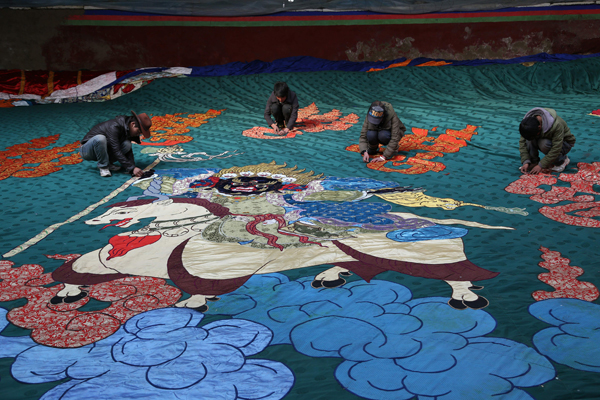Living master of thangka
 0 Comment(s)
0 Comment(s) Print
Print E-mail China Daily, April 3, 2013
E-mail China Daily, April 3, 2013
|
The 10,000-square-meter thangka was made in five parts before it was combined into a single piece. Apprentices work on a segment depicting Damjangarwanagpo, the protective deity of Tibetan Buddhism's Kagyupa sect. Photos by Daqiong / China Daily |
Migmar Tsering took nine years to finish his massive Tibetan work.
The Tibetan New Year of Losar celebrated on Feb 11 was "the happiest one" in the past 10 years for famed thangka master Migmar Tsering.
"My eight apprentices and I finally finished a huge thangka artwork before New Year's Eve after more than nine years of painstaking effort," says Migmar Tsering, who like all Tibetans is known by his four-syllable name.
The embroidered and painted masterpiece made in his home village of Chimakha some 140 km from Lhasa might be the largest of its kind in the world. It covers more than 10,000 square meters.
The 120-meter-long, 85-meter-wide artwork depicts 19 enlightened monks, the Buddha himself and two of his disciples, as well as many pagodas and 12 animals.
"Each earlobe of the Buddha is designed to be about 2 meters in length and the eyes of the monks are embroidered with silk to become more expressive and lifelike," Migmar Tsering says.
It is made in five parts that were spread out on the ground in his workshop before they were assembled into one piece.
This time Migmar Tsering did not follow the tradition of anonymity and sewed his name on the thangka in both Chinese and Tibetan.
He says the thangka will be donated to the Yangpajan Temple in the suburbs of Lhasa for display after it is blessed by lamas there.
"Buddhists and tourists from around the world will have a better chance to pay respect to the Buddha and pray for world peace," he says.
"Tibet has achieved rapid social and economic growth during the past decades and local people's lives have also greatly improved," Migmar Tsering says.








Go to Forum >>0 Comment(s)